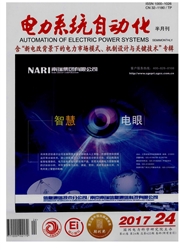

 中文摘要:
中文摘要:
提出了一种基于潮流追踪和凝聚算法的电力系统无功控制分区方法。该方法通过无功潮流追踪,确定无功源节点对各个节点无功输入的贡献比例,以此量化系统节点之间的无功耦合程度。在此基础上,定义了节点之间的距离,进而采用凝聚算法对系统所有节点进行聚合,并确定最优分区数目。IEEE39节点和IEEE118节点系统的分析计算验证了所述方法的有效性。所得无功控制分区能使分区内部的无功功率基本平衡,且能随系统运行条件的变化而变化。所提分区方法计算便捷,在实际系统中具有一定的应用价值。
 英文摘要:
英文摘要:
A power network partition method based on power flow tracing and agglomerative algorithm is proposed. Through reactive power flow tracing, the method can be used to identify the reactive power from each source to each load and hence quantify the degree of reactive power coupling between different nodes, and the distance between nodes can be thus defined. Agglomerative algorithm is then used to aggregate nodes and the best number of partition can be identified. The method is validated through case studies using the IEEE 39-bus and IEEE 118-bus system. The obtained partition can ensure a basically balanced reactive power within each area and change as system operation condition changes. The method has high computational efficiency and hence has the potential of practical application. This work is supported by National Natural Science Foundation of China (No. 50707029).
 同期刊论文项目
同期刊论文项目
 同项目期刊论文
同项目期刊论文
 期刊信息
期刊信息
